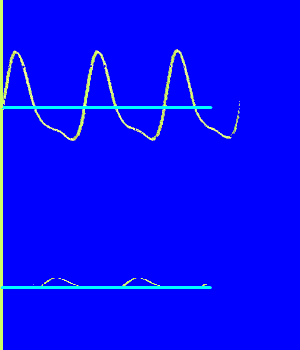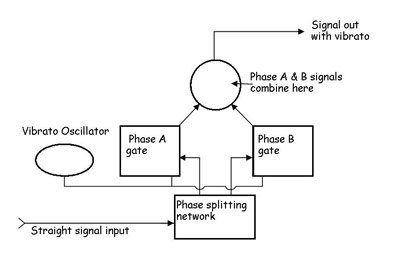Wurlitzer 4600 series
North Suburban Hammond Organ Service

This video shows you two identical signals that are 90° apart being alternately gated on and off to produce a unique type of vibrato.
Like the Hammond organs, the Wurlitzer electrostatic organs also rely on phase shifting to produce a true, pitch-varying vibrato, but the method and the final result are quite different from those of the traditional tone wheel Hammonds. It may be worth reviewing the operating principles of the Hammond vibrato before proceeding further, because the basic explanations there are somewhat relevant here.
The Wurlitzer vibrato, like that of the Hammond, happens after-the-fact. It is applied to the electrical signals from the reed unit, and like the Hammond vibrato, it will add vibrato to any audio signals that can be passed through the Wurlitzer amplifier treble channel input. The way it works is as follows.
First, the signal from the treble channel of the reed unit enters a phase-splitting network which produces two very close [but not quite exact] replicas of the signal but displaced in phase by approximately 90°. Because the audio signal is AC, this results in two-phase AC. After the signal has been converted to a two-phase signal, the two phases then pass through a gating circuit which selectively allows first the signal from one phase and then the signal from the other to pass through. The modulation of the gating circuit for each is arranged so that the signal gradually increases to full strength and then gradually decreases to zero and this occurs continuously at the vibrato rate which is typically 360 per minute for the slow vibrato, and 400 per minute for the fast vibrato. Note at this point the result for either phase is strictly an amplitude-varying tremolo with no frequency shift.
The frequency shift arises from two facts. Fact one; when the signal in one phase is increasing, the signal in the other phase is decreasing. Fact two; the signals are 90° out of phase. As the signal of one phase increases, that of the other phase decreases. The two signals are combined after the amplitude modulation, and when they are, they combine vectorially, meaning that the resultant signal gradually shifts in phase by 90°. If the signal whose phase is ahead is gradually fading out while the signal whose phase is lagging 90° behind is gradually increasing, the net result is that the vectorially combined composite signal will gradually shift in phase in the lagging direction from zero to -90°. The result of this is a decrease in the resultant signal's frequency.
As this process continues, eventually the resultant signal will consist entirely of the signal which is lagging 90° behind. Because both signals have at all times the same frequency, when this happens, the frequency will return to the original frequency. The greatest amount of pitch change occurs when both signals are partially gated and each signal is at 50% of its full strength value as one is increasing while the other decreases. Whenever the phase of a wave changes, this is always accompanied by a frequency change as well, but only while the phase is actually changing.

Block diagram of Wurlitzer ES organ vibrato system. A low frequency oscillator controls the two gate circuits, alternately turning them on and off at the vibrato rate. The audio signal enters the phase splitting network as shown which derives two signals from the single phase input, phase B lagging approximately 90° behind phase A. The two 90° out-of-phase signals are alternately gated and then mixed electrically as shown. The resulting signal is a replica of the input signal, but with a pitch shifting vibrato added.
Here's a simplified block diagram of the Wurlitzer vibrato system, and also a Flash animation illustrating how the two replicas of the signal which are phase-displaced by 90° are alternately gated on and off. Individual slight inaccuracies in the phase splitting network account for the fact that not all frequencies are shifted by exactly 90°, and also there is some slight amplitude variation in different parts of the phase splitter's two outputs also.
One of the nice features of this vibrato system is its inherent simplicity; there are no moving parts involved. This Flash diagram shows the actual waveforms and how they alternately increase and decrease in amplitude as a result of the gating circuits. Each signal has just a simple amplitude-varying tremolo. The magic happens when they are added together because the phase B signal is 90° out of phase [lagging behind] with the signal of phase A. The frequencies of both the phase A and phase B signals are constant. But when they are added they combine vectorially as shown on the next page which results in a combined signal that constantly changes phase by going -90° and then returning to zero phase shift. Whenever the phase of any type of wave changes, there will be a frequency change while the phase is changing. In the Wurlitzer vibrato, the phase constantly changes, first becoming increasingly lagging until it approaches -90° and then returning to 0°. This results in the output signal having vibrato with a slight pitch shift below and then above the input frequency for each cycle of vibrato. Over time, the average frequency of the output is the same as the frequency of the input, but its instantaneous value is constantly changing at the vibrato rate. Needless to say, this Flash animation is considerably slowed down from the normal vibrato rate of 6 to 7 times per second.
Its inherent simplicity, however, produces a type of vibrato that is somewhat different from standard vibrato, as I have detailed on the last page of this article. This may or may not be a bad thing, depending on one's individual opinion regarding what vibrato should sound like. As I mentioned above, this system will add vibrato to any audio signals that pass through it, so it could conceivably be used to add vibrato to the signal from an amplified chime unit [known in the pipe organ trades as a bongatron].
Previous Page Page 12. next Page